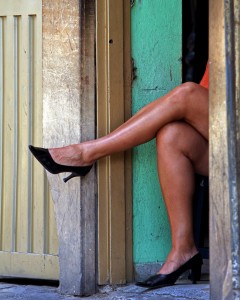A study released on Tuesday has shed new light on the multi-million dollar underground sex trade. Conducted by the Urban Institute, it examined eight major cities in the United States, drawing upon interviews with pimps, traffickers, sex workers, child pornographers, and law enforcement.
The full report is a fascinating read, chock full of data that the institute hopes will inform future policy decisions. Here is a breakdown of some of the study’s most interesting findings:
- In 2007, the underground commercial sex trade (which includes sex trafficking, prostitution, erotic massage parlours, internet-based prostitution, and brothels) had an estimated net worth of $39.9 million to $290 million, depending on the city.
- Unsurprisingly, pimps earn a lot more than prostitutes, with weekly incomes ranging from $5,000 to $32,833.
- Many pimps felt the term “pimp” was derogatory and objected to media representations of them that emphasize violence—despite the fact that they admitted to using violence from time to time as a means of punishment.
- Psychological coercion appears to be a major factor in the recruitment and retention of sex workers. Some pimps even credited their entry into pimping with a “natural capacity for manipulation.”
- The internet is dramatically changing the nature of the sex industry, as prostitution moves from the streets to online venues such as Craigslist.com and Backpage.com.
The question of whether or not sex work should be legal is a contentious issue in many parts of the world. Lately, there has been talk about the advantages of the “Nordic model,” which decriminalizes prostitutes, while criminalizing johns and pimps.
Canada’s own laws are complex: While there are no laws prohibiting the exchange of sex for money, historically, activities associated with prostitution, such as running a brothel, have been illegal. This changed in December 2013 when the Supreme Court of Canada ruled that such laws were unconstitutional. The government of Canada is currently seeking public opinion on its response to prostitution through its “Public Consultation on Prostitution-Related Offences.” This online questionnaire is available until March 17th.
Want to be well-informed before you fill out that questionnaire? UTP Journals has a great selection of articles on prostitution you can read. In “Criminalization and Off-Street Sex Work in Canada,” from Canadian Journal of Criminality and Criminal Justice 53.2, Tamara O’Doherty interviews 10 women to determine how criminalization effects the health and safety of indoor sex workers.
Also check out
“Attitudes, Beliefs, and Knowledge of Prostitution and the Law in Canada” (CJCCJ 54.2)
“Bad Dates and Street Hassles: Violence in the Winnipeg Street Sex Trade” (CJCCJ 52.2)
“Expanding the Scope of Inquiry: Exploring Accounts of Childhood and Family Life among Sex Workers in London, Ontario” (CJHS, Advanced Online)
“Public Opinion on Prostitution Law Reform in Canada” (CJCCJ 54.2)
“Sex Work in New Zealand: The Re-Importation of Moral Majoritarianism in Regulating a Decriminalized Industry” (CJWL 24.2)
“Shifting the Focus: Restorative Justice and Sex Work” (CJCCJ 52.3)
Should prostitution be decriminalized? Share you views with us on Twitter @utpjournals.

Comments on this entry are closed.